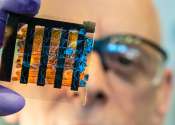Ultra-sensitive optical sensor can reduce hydrogen's risks
In the pursuit of clean and renewable energy, hydrogen plays an important role. But a major challenge facing this transition is that the gas is explosive when mixed with air. For this reason, it is crucial to be able to detect ...
Nov 30, 2022
0
62









